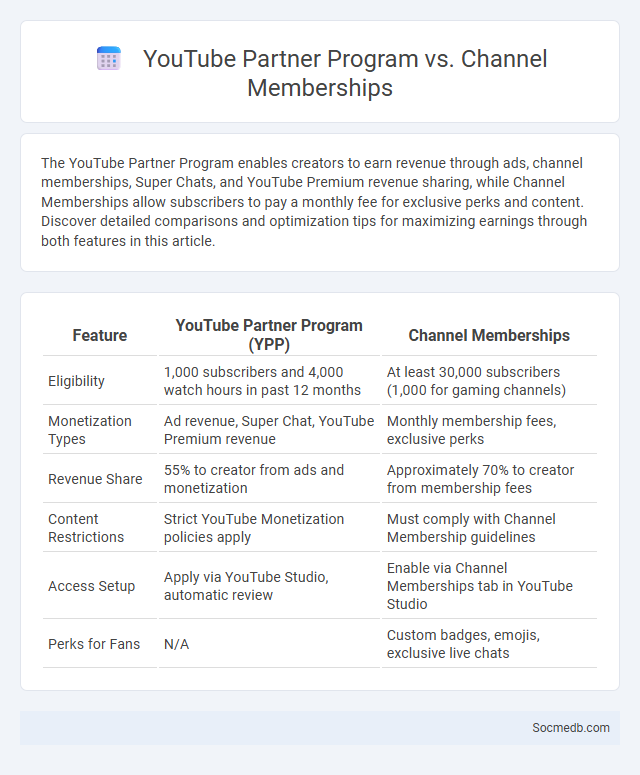
Photo illustration: YouTube Partner Program vs Channel Memberships
The YouTube Partner Program enables creators to earn revenue through ads, channel memberships, Super Chats, and YouTube Premium revenue sharing, while Channel Memberships allow subscribers to pay a monthly fee for exclusive perks and content. Discover detailed comparisons and optimization tips for maximizing earnings through both features in this article.
Table of Comparison
| Feature | YouTube Partner Program (YPP) | Channel Memberships |
|---|---|---|
| Eligibility | 1,000 subscribers and 4,000 watch hours in past 12 months | At least 30,000 subscribers (1,000 for gaming channels) |
| Monetization Types | Ad revenue, Super Chat, YouTube Premium revenue | Monthly membership fees, exclusive perks |
| Revenue Share | 55% to creator from ads and monetization | Approximately 70% to creator from membership fees |
| Content Restrictions | Strict YouTube Monetization policies apply | Must comply with Channel Membership guidelines |
| Access Setup | Apply via YouTube Studio, automatic review | Enable via Channel Memberships tab in YouTube Studio |
| Perks for Fans | N/A | Custom badges, emojis, exclusive live chats |
Overview of YouTube Monetization Options
YouTube offers several monetization options, including AdSense revenue from video ads, channel memberships that provide exclusive perks to subscribers, and Super Chat for live stream donations. Creators can also earn through YouTube Premium revenue, where subscribers pay for ad-free content, and merchandise shelf integration to sell branded products directly on their channel. Leveraging multiple revenue streams enables creators to maximize income potential while engaging their audience.
What is the YouTube Partner Program?
The YouTube Partner Program (YPP) enables content creators to monetize their videos through ads, channel memberships, and merchandise shelves by meeting eligibility criteria such as 1,000 subscribers and 4,000 watch hours in the past 12 months. Approved partners gain access to YouTube's monetization features, detailed analytics, and creator support tools, enhancing content reach and revenue potential. Participation in YPP requires adherence to YouTube's community guidelines and advertiser-friendly content policies to maintain monetization privileges.
Understanding Channel Memberships
Channel memberships on social media platforms allow creators to offer exclusive content and perks to subscribers, enhancing audience loyalty. By leveraging membership features, you can monetize your channel while building a dedicated community that values your unique offerings. This strategic approach increases engagement and provides a steady revenue stream aligned with your brand goals.
Eligibility Requirements: Partner Program vs Channel Memberships
Eligibility requirements for the Partner Program typically include a minimum subscriber count, consistent content upload frequency, and adherence to community guidelines, while Channel Memberships require your channel to be in good standing with a certain number of subscribers, often lower than the Partner Program threshold. Your channel must meet the platform-specific criteria such as watch hours and monetization policies to qualify for both options. Understanding these distinct requirements helps optimize your channel's revenue potential and audience engagement strategies.
Revenue Streams: AdSense, Memberships, and More
Social media platforms generate significant revenue through multiple streams, including Google AdSense, which monetizes user-generated content via targeted advertisements. Membership models offer exclusive content and features, driving subscription income alongside traditional ads. Emerging revenue sources like branded partnerships, in-app purchases, and data-driven marketing further diversify earnings for sustained growth.
Feature Comparison: Partner Program vs Channel Memberships
Social media platforms offer distinct monetization opportunities such as the Partner Program and Channel Memberships, each tailored to different creator needs and engagement levels. The Partner Program typically provides ad revenue sharing and broader access to platform tools, while Channel Memberships focus on exclusive content and perks for paying subscribers, enhancing viewer loyalty. Understanding these differences helps you choose the best option to maximize your income and audience interaction effectively.
Pros and Cons of the YouTube Partner Program
The YouTube Partner Program offers creators opportunities to monetize their content through ads, channel memberships, and Super Chat, boosting Your potential earnings and audience engagement. However, strict eligibility requirements, such as 1,000 subscribers and 4,000 watch hours, plus ongoing adherence to community guidelines, can limit access and risk demonetization. Balancing these pros and cons helps You determine if joining the program aligns with Your content goals and growth strategy.
Benefits and Drawbacks of Channel Memberships
Channel memberships on social media provide creators with a steady revenue stream through monthly subscriptions, allowing You to access exclusive content, badges, and community perks that foster deeper engagement. However, drawbacks include potential alienation of non-paying followers and the risk of creating content gaps between members and general viewers. Balancing membership benefits with inclusive content remains crucial for sustainable audience growth and satisfaction.
Choosing the Best Monetization Strategy for Your Channel
Selecting the best monetization strategy for your social media channel depends on audience demographics, engagement rates, and content niche. Influencer partnerships, affiliate marketing, and ad revenue each offer unique revenue potentials and require tailored approaches for maximized returns. Analyzing platform-specific algorithms and user behavior enhances the effectiveness of chosen monetization methods.
Frequently Asked Questions about YouTube Monetization Options
YouTube monetization options include ad revenue, channel memberships, Super Chat, and merchandise shelf. Your eligibility depends on meeting specific criteria like 1,000 subscribers and 4,000 watch hours within the past 12 months. To maximize earnings, ensure your content follows YouTube's monetization policies and utilize multiple revenue streams effectively.
 socmedb.com
socmedb.com